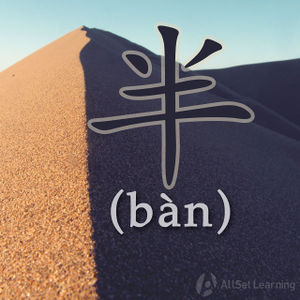Expressing "half" with "ban"
The Chinese word 半 (bàn) means "half." That's simple enough, but what can get slightly tricky is the rules for how it combines with measure words.
Contents
Standard Usage
Used alone
Structure
半 + Measure Word + Noun
Examples
The measure words are also indicated below.
- 半 个 小时 half an hour
- 半 个 月 half a month
- 半 碗 米饭 half a bowl of rice
- 半 瓶 酒 half a bottle of liquor
- 半 份 炒面 half a serving of chow mein
With a Number
When it's more than just a half, then 半 (bàn) comes after the measure word instead of before. It's the difference between "half an hour" and "an hour and a half." The order is actually basically the same as what we do in English (we just don't have so many pesky measure words to keep track of in English!).
Structure
Number + Measure Word + 半 + Noun
Examples
- 三 个 半 小时 three and a half hours
- 两 个 半 月 two and a half months
- 一 斤 半 水果 one and a half (kilograms) of fruit
- 一 瓶 半 白酒 one and a half bottles of wine
- 四块 半 巧克力 four and a half pieces of chocolate
Notable Exceptions
There are some words that act as their own measure words, notably the time words 天 (tiān), meaning "day," and 年 (nián), meaning "year."
Used alone
Structure
半 + 天/年
Examples
- 半 天 half a day
- 半 年half a year
Note that you do not need to use 个 (ge) here; in fact, it's wrong to do so:
- 半 个 天 half a day
- 半 个 年 half a year
With a Number
Structure
Number + 天/年 + 半
Examples
- 两 天 半 two and a half days
- 一 年 半 a year and a half
- 三 天 半 three and a half days
- 四 年 半 four and a half years



